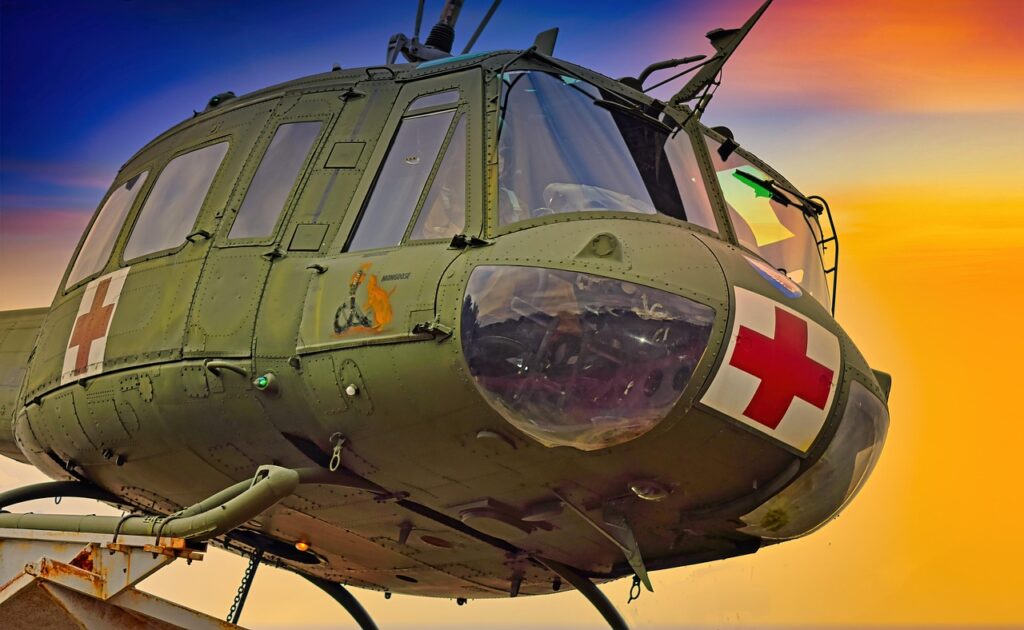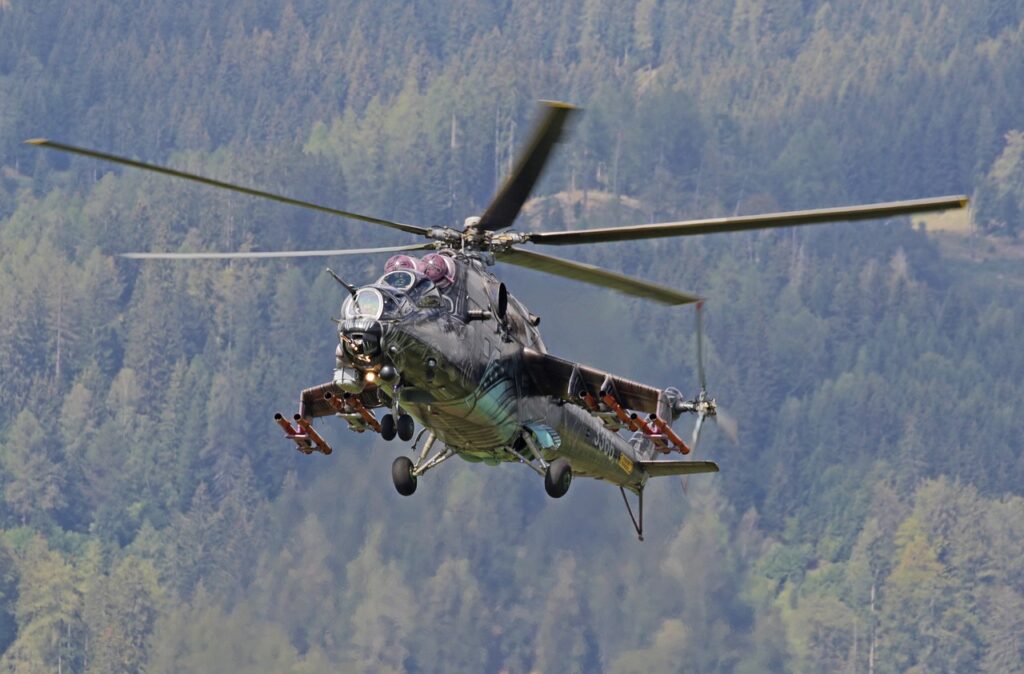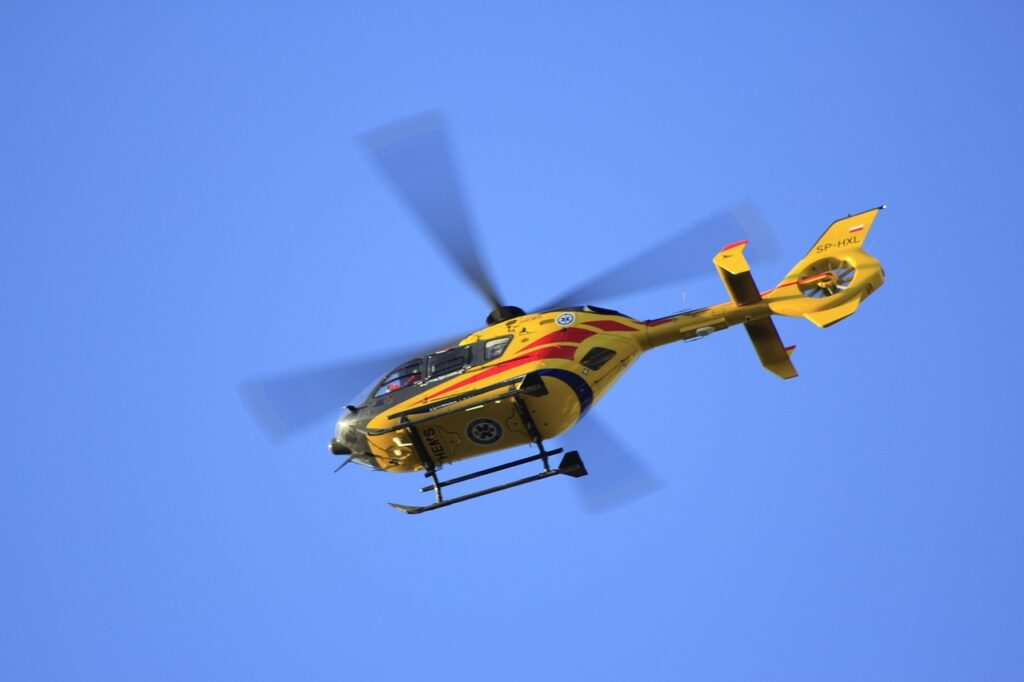How Does a Helicopter Work?

Have you ever looked up at the sky and seen a helicopter hovering in the air, just begging the question, how is it hanging out there, not just falling? Helicopters are different than airplanes. Airplanes need to keep moving forward to maintain flight. Helicopters can hover, fly sideways, and have vertical takeoff. How can it do this? How does a Helicopter work?
In this blog, we’ll describe how a helicopter works using simple wording. We’ll provide brief background information on helicopters, and the physics of flying a helicopter. By the end, you’ll see the beauty in the science behind helicopters.
What Is a Helicopter?
How does a Helicopter work? A helicopter is a type of rotary-wing aircraft. Unlike airplanes that use fixed wings to create lift, helicopters have one or more spinning rotors (blades) on top. These rotors generate lift by moving air downward, allowing the helicopter to rise, hover, or move in any direction.
Main Components of a Helicopter:
Before we get into the physics, let’s examine the major components of a helicopter:
1. Main Rotor Blades:
The large blades that rotate above the helicopter that provide lift.
2. Tail Rotor:
Located at the end of the tail, the smaller rotor that allows directional control of the helicopter and also stabilizes the helicopter.
3. Engine:
Provides the power to rotate the blades.
4. Fuselage:
The main body that carries passengers, cargo, and the pilot.
5. Landing Skids or Wheels:
Allow for safe landings and take off from the ground.

The Physics Behind Helicopter Flight
Now let’s bring these concepts back into physical terms using simple examples.
1. Lift and Newton’s Third Law
Lift is what holds the helicopter up inward. Lift is an upward force derived from the downward force created by the helicopter’s rotor blades.
The rotor blades are like two spinning wings. In the case of the blades, as they are spinning, they are pushing air downward. When air is being pushed downward, according to Newton’s Third Law of Motion—“For every action there is an equal and opposite reaction”—the downward force will in turn produce an upward reaction force that creates lift.
An easy way to think about is to imagine jumping out of a boat. When you jump off the boat it slides or moves backward. When the blades push the air down, the helicopter rises.
How does a Helicopter work?
2. Bernoulli’s Principle
Each blade of the main rotor is shaped like an airplane wing (called an airfoil). As the blades spin, the air moves faster going over the curved top of the blade and slower moving underneath.
According to Bernoulli’s Principle, the speed of air will determine the air pressure. Faster moving air results in lower pressure. As a result, the pressure on top of the blade is lower than the pressure underneath the airfoil. The pressure difference on the airfoil (blade) creates lift.
In summary, there are two main forces that create lift:
Newton’s Third Law (action-reaction).
Bernoulli’s Principle (pressure difference).
How does a Helicopter work?
3. Thrust and Directional Control
Helicopters can move beyond just up and down; they can also move in the forward, backward, and sideways direction! This is achieved because each rotor blade can have its angle at the same time; this is called cyclic pitch control.
When the angle of attack (the tilt of the blades) changes, the helicopter tilts in that direction. This angle change happens at specific moments throughout the rotation and allows the pilot to smoothly steer the helicopter.
4. Torque and the Tail Rotor
The moment the main rotor spins, the helicopter body is acted upon by an equal and opposite twisting force (this is the third law of Newton). Without a force counteracting the torque, the helicopter would spin out of control.
Enter the tail rotor. The tail rotor pushes air sideways, which is a force acting at 90 degrees to the helicopter body, counteracting the torque. This keeps the helicopter stable but also allows the helicopter to turn left or right (this is called yaw).
How does a Helicopter work?

Why Helicopters Can Hover:
Airplanes have to keep moving forward to stay in the air since they require airflow over the wings to generate lift but helicopters have no such constraints. As long as the rotor blades are spinning (or turning), they have air flowing over them so they will always be push air down and creating lift.
Since helicopters can create lift without forward motion, they can hover in place, which provides plenty of flexibility for search and rescue, military operations, and even landing in tight areas.
How does a Helicopter work?
Helicopter Controls – Simply Explained
How does a Helicopter work? Pilots are required to use three main controls to fly a helicopter:
1. Collective Pitch Control:
Changes the pitch (angle) of all rotor blades at the same time. Adding pitch to all rotor blades increases or decreases lift thus allowing the helicopter to ascend or descend.
2. Cyclic Pitch Control:
Changes the pitch of each blade based upon its position. Controls the forward, backward and side-to-side motion of the helicopter.
3. Anti-Torque Pedals:
Controls the amount of force of the tail rotor. Used to yaw the helicopter (turning left or right).
Energy and Power:
How does a Helicopter work? Operating a helicopter requires a large amount of power. Most helicopters are powered by turbine engines, which combust fuel to create mechanical power to turn the rotors. These engines need to be robust and reliable, as while hovering, helicopters use more power than while traveling forward.
Safety & Skill
Helicopter flight is difficult because there are so many knobs and controls to think about. The pilot needs to keep the helicopter balanced while managing altitude, direction and speed, which often are happening all at the same time.
How does a Helicopter work?
Real-World Uses of Helicopters:
Helicopters are flexible and have many uses:
– Emergency Medical Services (EMS), to transfer patients speedily.
– Rescue missions in austere and dangerous environments.
– Military operations to move troops and supplies.
– News and traffic reporting, allowing reporters to see, in real time, and create aerial views that are not possible other than by helicopter.
– Tourism and photography to create and capture views and scenery that can only be seen from the air.

Conclusion:
Helicopters are incredible machines. Now you can understand how does a Helicopter work. The ability to hover, vertically lift off the ground, and fly in spaces where no other flying machine can go is completely unique, and therefore helicopters are often irreplaceable in many circumstances. Helicopters have a surprising amount of complex physics behind their seemingly effortless flight. The various principles of flight mechanics and the laws of physics, mostly Newton’s Third Law of Motion and Bernoulli’s Principle, all contribute to making a helicopter fly.
It is valuable to understand how helicopters work because it furthers an appreciation for helicopter engineering, but also depicts the amazing importance of physics in everyday machines!
FAQs – Frequently Asked Questions-How Does a Helicopter Work?
Q1: What distinguishes a helicopter from an airplane?
Ans: An airplane must move forward in order to fly; however, a helicopter can take off vertically and hover. A helicopter produces lift with rotary rotors instead of fixed wings.
Q2: What happens if I lose my engine?
Ans: In a helicopter you can perform an emergency maneuver called autorotation. By taking advantage of the airflow while descending, the rotors will continue spinning and you will be able to safely land.
Q3: Can you fly a helicopter upside down?
Ans: Some high-performance helicopters that are capable of aerobatics can briefly fly upside down, but most helicopters cannot. Helicopter blades and engines are not designed for inverted flight for any length of time.
Q4: Why are helicopters so loud?
Ans: Helicopters are loud because of the quantity and speed at which they are moving air with the spinning rotors. The engine also contributes to the noise.
Q5: Are helicopter’s more dangerous than airplanes?
Ans: Statistically helocopter’s have a higher accident rate, primarily due to their more complicated flying mechanics. Helicopters are also statistically at a higher risk of being involved in an accident. That said, with proper maintenance and experienced pilots, helicopters are generally quite safe.

